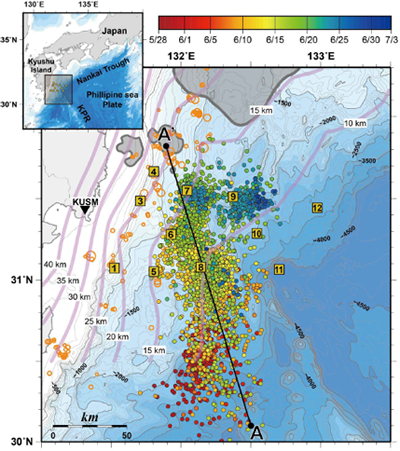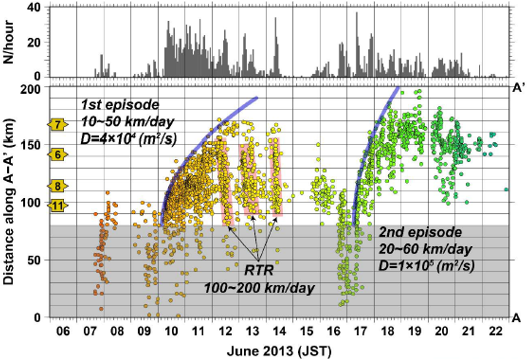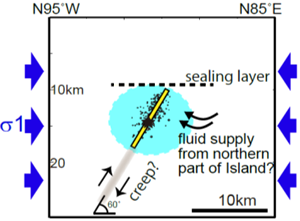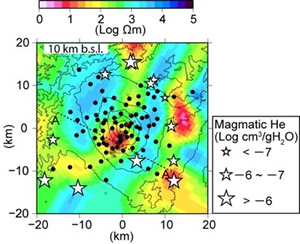
HOME / Departments / Earth and Planetary Sciences / Observational Seismology and Volcanology, Geohazard Mitigation Science
Observational Seismology and Volcanology, Geohazard Mitigation Science
-
- MATSUMOTO Satoshi, Professor
- AIZAWA Koki, Associate Professor
- EMOTO Kentaro, Associate Professor
- BABA Satoru, Assistant Professor
- Our group is studying on earthquakes and volcanic eruptions based on mainly geophysical observations, especially seismic, geodetic and electromagnetic observations. The final goal of our study is the prediction of earthquakes and volcanic eruptions by understanding the physical process of preparation of earthquakes and volcanic eruptions. We have revealed the seismic activity and stress-strain field in the crust including active faults and volcanoes. We have also investigated seismological structure, electrical resistivity structure and their space-time changes. Our center for the observation is the Institute of Seismology and Volcanology, located at Shimabara City on the foot of Unzen Volcano.
1. A study on the preparation process of inter-plate earthquakes
— New finding of migrating low-frequency tremor on the subduction interface off southern Kyushu —

The shallow slow earthquakes occurring at up-dip side of megathrust seismogenic zone are important to understand the dynamics of shallower part of subduction zones and generation of tsunami-genic earthquake. We clarify the nature of shallow low-frequency tremor activity as a completed episode associated with shallow very-low-frequency earthquakes (VLFE) for the first time. The shallow tremor episode exhibited two migration modes reminiscent of deep tremor down-dip of the seismogenic zone in some other subduction zones: a large scale slower propagation mode and a rapid reversal mode. These similarities in migration properties and the association with VLFE strongly suggest that both the shallow and deep tremor and VLFE may be triggered by the migration of episodic slow slip events.

2. A study on the preparation process of intra-plate earthquakes
— Stress condition in the crust —

One approach that can be used to evaluate the potential for an earthquake occurrence is the detection of the stress concentration at an earthquake fault. While the stress fields for pre- and post-seismic event stages differ, this change cannot provide information regarding the potential for an earthquake. Here, we developed a detection method for states of stress that uses focal mechanism data from microearthquakes. We applied this method to actual focal mechanism data from the 2013 Awaji Island earthquake (M6.3), Japan, and the results showed the presence of stress concentration around the earthquake fault before the mainshock. In addition, the regional differential stress was shown to be about 13 MPa. The magnitude of the obtained stress concentration in the focal area and the high dip angle of the mainshock fault imply that the faulting occurred in the crust where it was overpressurized to a level near the lithostatic pressure. [Matsumoto et al., Tectonophysics (2015) doi:10.1016/j.tecto.2015.02.023]
3. A study on the preparation process of volcanic eruptions
— Pressure sources of the Miyakejima volcano estimated from crustal deformation studies —
Following the 2000 eruption of the Miyakejima Islands, a continuous GPS network observed the ongoing contracting crustal deformation. Subsequently, a slight inflation of the island was detected from around 2006, and we initiated a campaign of dense GPS observations around the volcano from 2011. We estimated that three magma sources (a shallow deflation sill under the crater, a southern inflation dyke, and a deep inflation spherical source) were activated during 2011–2013. We therefore posit that the supply of magma from a deep spherical source to the new dyke source has been initiated. [Fukui et al., Int. Assoc. Geodesy Symp. (2015) doi:10.1007/1345_2015_150]
4. A study on the interaction between earthquakes and volcanic activities
— Earthquakes triggered by gas rich fluids —

Large earthquakes sometimes trigger local seismicity that is distal to their rupture zones. Various mechanisms for this triggered seismicity have been proposed, based on either the static stress change or ground shaking from seismic waves, but local geological structure is rarely studied to discern why this seismicity is remotely induced. We conducted joint 3-D resistivity and isotopic analysis of the groundwater system surrounding Mt. Fuji, where increased seismicity was observed following the 2011 Tohoku-Oki megathrust earthquake, and imaged a previously unknown N20°E–S20°W trending fracture zone that allows magmatic gas (CO2 and He) to preferentially move upward through the groundwater network. The local seismicity triggered by the Tohoku-Oki megathrust earthquake occurred within this gas pathway. Based on the results, we calculated that the upwelling of gas-rich hydrous fluids and/or gas bubbles can induce pore pressure increase enough to promote earthquake generation. These types of gas pathways are also present beneath active faults, and therefore be important not only for triggering seismicity beneath volcanoes, but for generating inland earthquakes. [Aizawa et al., Geology (2016) doi:10.1130/G37313.1]